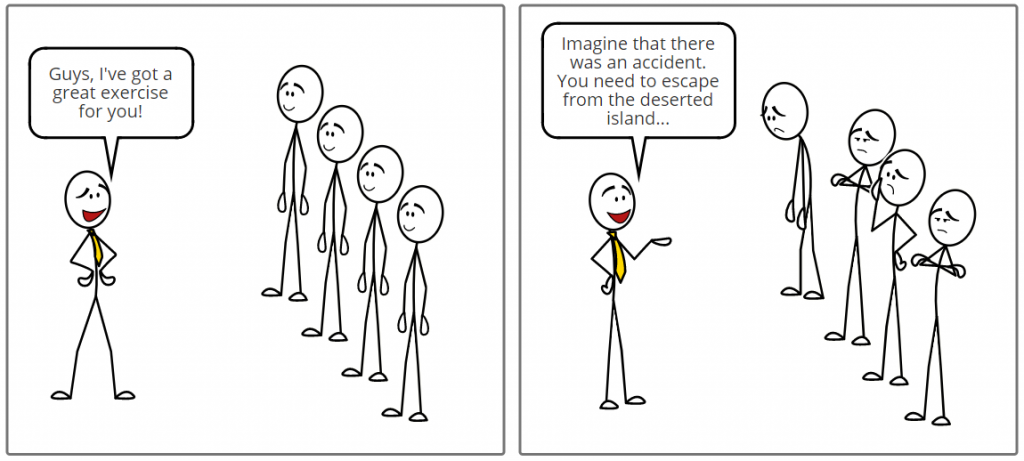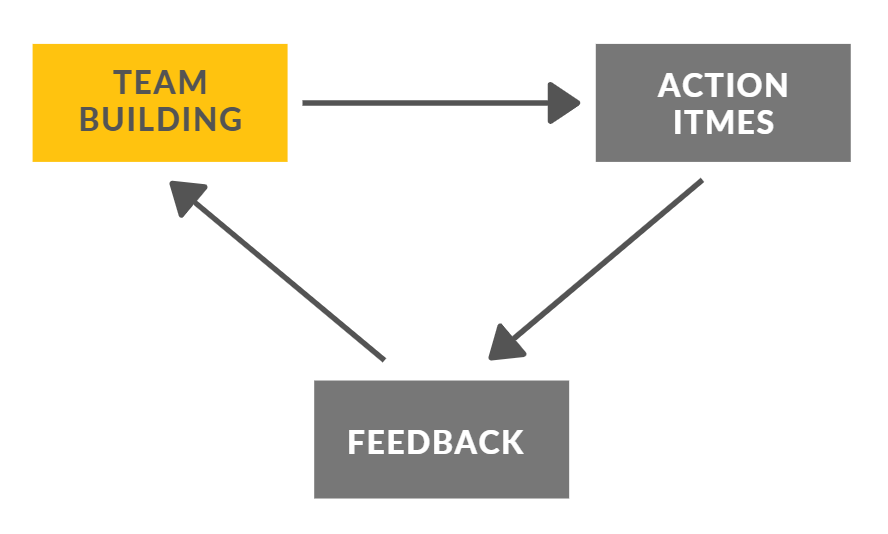
Team building can sound scary to a lot of people. It’s typically associated with meeting your coworkers in order to do mundane or ridiculous stuff, like singing a song or holding each other’s hands.
Something that is meant to be fun but that some of you will consider a nightmare. Something that is meant to improve teamwork but in fact doesn’t bring any value to your team. Those types of team building activities may do very little to deliver long-lasting results and they can even cause irreparable damage.
“Poorly designed team building exercises may lead on failure of team building interventions and also team structure.”
You can read more about what is wrong with most team building activities and how they actually differ from social events in another article of mine. But here and now it’s time to show you a couple of proven strategies of organizing team building activities that actually work. Those strategies were studied and proved to be effective in teamwork development.
#1 Use real-world exercises
According to a study regarding the impact of team building exercises on team effectiveness [1], if you want to make your team building exercises live up to their full potential, it’s necessary to align them with real-time work goals. It doesn’t make sense to use artificial examples made up just for the purpose of your workshops. Of course, they can be treated as social events, but as Kenneth Stålsett managed to prove in his doctoral thesis, they won’t positively affect team effectiveness.

And by the way, what’s the point of playing one of the “fun” games and pretending that you need to escape from a deserted island, when there are real issues to deal with? It carries a risk that people will find it childish and pointless, a waste of time really. I’ve seen many senior employees and experts actually fleeing such events because they were asked to play “human knots” or build a construction out of sheets of paper. Not everyone likes to play foolish games.
If you expect to achieve real outcomes from team building activities, don’t make them up without a work context. Let’s say your teammates struggle with conflicts at work. Then you need to prepare interactive workshops based on the conflict situations they experience on a daily basis. If there is a conflict between software developers and testers, you can arrange a couple of scenarios tackling that problem from different angles. Show them how to share opinions and feedback in an effective way (without harming each other), how to negotiate a final solution or a deadline and how to explain the details of a problem. Use anything that currently seems to be an issue in a team. There are no better exercises than the ones you experience in real life.
#2 Make sure it’s interactive
Organizing lectures is not enough. As a manager, if you care just about crossing off “teamwork improvement” of your to-do list, you can go for it. But if you want to improve team performance in a real way, you need to focus on practice. The research regarding the effectiveness of teamwork training [2] suggests that:
“(…) simply providing educational lectures wherein team members passively learn about teamwork is not an effective way of improving teamwork.”
Make sure that your workshops actually enable people to face an issue and approach it, instead of passively listening to experts and bookish solutions. I know it’s easier to invite external experts and coaches to deliver motivational talks and power pitches, but such a solution won’t impact teamwork at all and it won’t solve any problems. You need to put more energy and time into organizing and facilitating proper team building activities. Organize only those activities that are based on real-time work and the ones that can be practiced interactively by each team member. If you want them to remember and learn, engage them.
#3 Build the team’s strength gradually
There is a high probability that after spending a few hours on a team building event, people will go back to their old habits and behaviors later on. It’s easy to assume any kind of behavior if you need to practice it just for a couple of minutes and, more importantly, your manager is watching. But it can be difficult to mimic it in the office afterward. To change deeply-rooted behaviors you need to incorporate a long-term approach, something that will become a part of the culture of your organization.

You shouldn’t focus on a single learning event but rather on a learning strategy. Ms. Neelam Saraswat and Dr. Shilpi Khandelwal [1] proved that long-term effectiveness is enhanced when organizations incorporate team building exercises into an overall company structure. After organizing the first team building activity, think about follow-up sessions and feedback loops. You should arrange a time to review with your team what’s been improved during your training and what still needs to be improved.
#4 Actionable ideas
Great ideas and discussions are nothing if there are no action items. If you just want to spend a few hours discussing the problems and complaining about a tough situation without creating a plan to fix it, forget about it. Each team building session should result in actionable ideas or insights written down by team members. They need to find out and agree on how to tackle their specific problems. In their study, Ms. Neelam Saraswat and Dr. Shilpi Khandelwal suggest [1] that:
“Team building should result in actionable ideas to help the team and the organization achieve their goals.”
If workshops gave your guys a chance to learn how to improve negotiations with a customer, let them reflect on it and create actions based on that knowledge. They had the opportunity to practice it during interactive workshops and now they can have some fresh, valuable insights. As a result, they should agree upon a common approach and write it down.
For instance, their solution may be that from now on there will be one person who represents the team and is responsible for negotiating a plan with a client. Or maybe first they need to establish a common approach within the team before it’s communicated to a customer. Or perhaps they should figure out the way the team members communicate negative opinions among each other.
Anything a team finds out during workshops that can improve the way they work should stay remembered and be reviewed later on. A team building facilitator should make sure that each event ends with an enhancement to be introduced by a team in their everyday work.
The conclusion
Team building exercises don’t need to be connected to silly activities you might have heard about. You don’t need to climb trees, roll on the floor or sing a song to make your team become performative. Watch out for poorly facilitated social events because they can make more harm than good to your team [1].
If you’re considering improving teamwork in your company, think about exercises that will help you solve real-world problems and don’t treat them as a one-time session. Team building should be a long-term process, not a single event.
References
[1] Ms. Neelam Saraswat, Dr. Shilpi Khandelwal. (2015). Impact of Team Building Exercises on Team Effectiveness. International Journal of Marketing and Human Resource Management (IJMHRM); Volume 6, Issue 3, Sep-Dec (2015), pp. 89-97.
[2] McEwan, D., Ruissen, G. R., Eys, M. A., Zumbo, B. D., & Beauchamp, M. R. (2017). The effectiveness of teamwork training on teamwork behaviors and team performance: A systematic review and meta-analysis of controlled interventions. PLoS ONE, 12(1), Article e0169604.